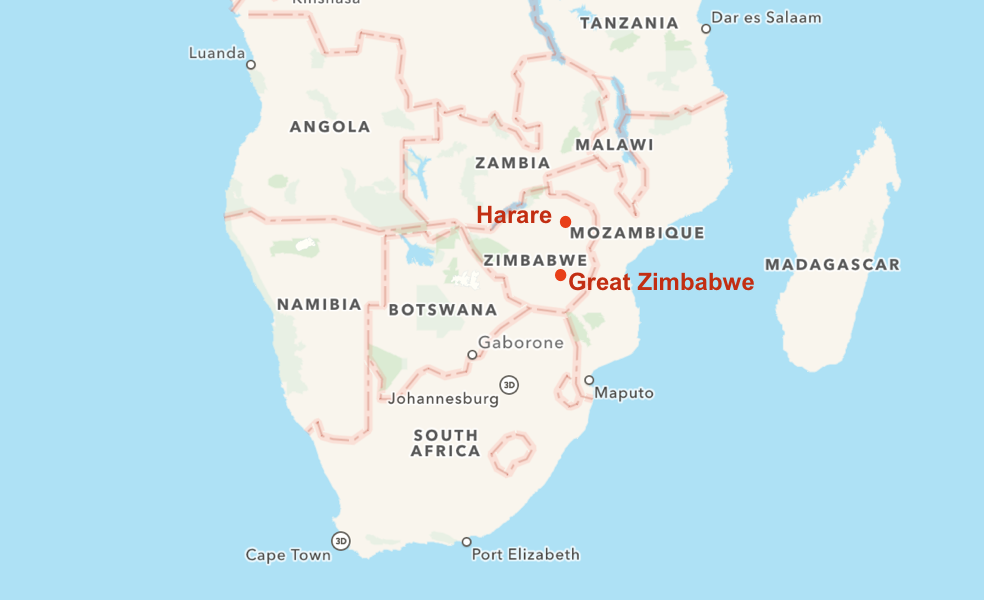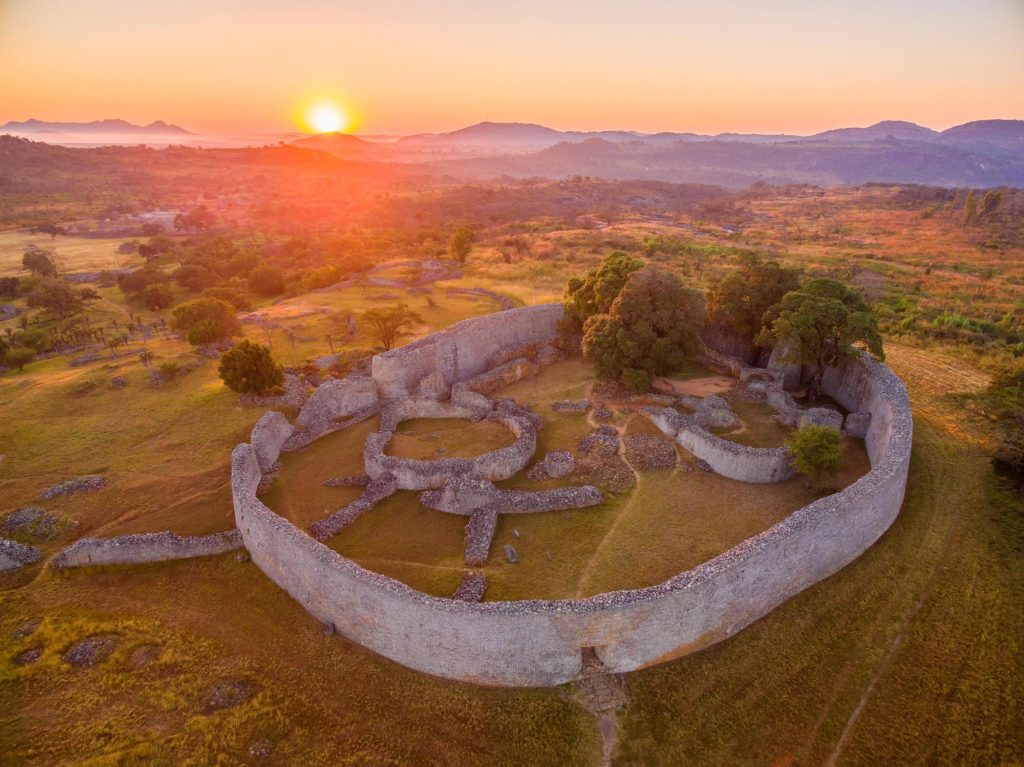ក្រេច ហ្សីមបាវ៉េ (Great Zimbabwe) គឺជាឈ្មោះនៃទីក្រុងបុរាណដ៏សំខាន់មួយដែលបង្ហាញអំពីអរិយធម៌នៃអាណាចក្រ ហ្សីមបាវ៉េ ហើយសព្វថ្ងៃស្ថិតនៅខាងជើងនៃប្រទេសហ្ស៊ីមបាវ៉េ (Zimbabwe)។ នៅក្នុងទឹកដីនៃតំបន់អរិយធម៌នេះ សំបូរដោយជនជាតិ បុនទូ ( Buntu) ដែលជាជនជាតិបុរាណរស់នៅក្នុងទឹកដីនៃប្រទេសអាហ្វិ្រចខាងត្បូងមួយនេះតាំងពីដើម។ Zimbabwe ក្នុងភាសា Buntu មានន័យថា ផ្ទះថ្ម ( stone house)។
អរិយធម៌ ឬអាណាចក្រ ហ្សីមបាវ៉េ គឺជាផ្នែកមួយដ៏សំខាន់នៃបណ្តាញផ្លូវពាណិជ្ជកម្មនៅក្នុងតំបន់អាហ្វិ្រចខាងជើង។ តាមរយៈការសិក្សាផ្នែកបុរាណវិទ្យានៅក្នុងតំបន់នេះ អ្នកបុរាណវិទូបានរកឃើញនូវកុលាលភាជន៍ដែលមានប្រភពមកពីចិន ពែក្ស និងជាពិសេសកាក់ប្រាក់ដែលមកពីតំបន់អារ៉ាប់ជាដើម។ ការរកឃើញនៃវត្ថុតាងទាំងនោះបានបង្ហាញអំពីវិសាលភាពនៃការជួញដូររវាងអរិយធម៌នេះ និងអរិយធម៌ដទៃទៀត។

ទីក្រុង ក្រេច ហ្សីមបាវ៉េ ( (Great Zimbabwe) គឺមានចម្ងាយប្រមាណជាង ៣០គីឡូពីទីក្រុង Masvingo និងស្ថិតនៅខាងជើងនៃប្រទេសហ្សីមបាវ៉េ។ ទីក្រុងបុរាណនេះ គឺជារាជធានីដ៏សំខាន់នៃអាណាចក្រ Zimbabwe និងត្រូវបានបង្កើតឡើងប្រហែលស. វ.ទី១២ នៃគ.ស. និងត្រូវបានបោះបង់ចោលនៅស.វ.ទី១៥ ពោលគឺស្ថិតនៅចន្លោះឆ្នាំ១១០០ដល់ឆ្នាំ១៤៥០នៃគ.ស.។ ទីក្រុងនេះមានផ្ទៃដីជាង៨០០ហិចតា ដោយបែងចែកជាបីតំបន់ផ្សេងៗ គឺតំបន់មានប្រាសាទនៅលើភ្នំ (Hill Ruins), តំបន់មានជញ្ជាំងខ្ពស់ (Great Enclosure) និងតំបន់ប្រាសាទនៅតាមជ្រលងភ្នំ ទន្លេ (Valley Ruins)។

តំបន់មានប្រាសាទលើភ្នំ គឺជាបណ្តុំនៃសំណង់ប្រាសាទដែលកសាងចាប់ពីកំពូលភ្នំ ដេញរហូតដល់ចង្កេះភ្នំ។ ចំពោះទីតាំងនេះ កសាងសម្រាប់កន្លែងប្រារព្ធពិធីសាសនា ហើយតំបន់នេះ គឺចាស់ជាងតំបន់ពីរផ្សេងទៀត ដែលប្រហែលជាកសាងនៅស.វ.ទី១០ នៃគ.ស.។ តំបន់នេះចាត់ទុកជាវាំង និងជាកន្លែងសំខាន់នៃក្រេច ហ្សីមបាវ៉េទាំងមូល។
តំបន់ទី២ គឺជាតំបន់មានជញ្ជាំងខ្ពស់ ដែលស្ថិតនៅខាងត្បូង នៃតំបន់ទី១ ដោយនៅទីនេះកសាងជញ្ជាំងអំពីថ្ម ដែលមានកំពស់៩.៧ ម៉ែត្រ និងកសាងនៅស.វ.ទី ១៤នៃគ.ស.។ បច្ចេកទេសភ្ជាប់ថ្មនៅទីនេះ គឺប្រើប្រាស់ជាមួយនឹង Mortar។

រីឯតំបន់ទី៣វិញ គឺជាតំបន់ដែលមានផ្ទះប្រជាជនរស់នៅ ស្ថិតនៅក្បែរនឹងតំបន់ទី២ ដោយផ្ទះទាំងនោះធ្វើពីភក់លាយជាមួយដីឥដ្ឋ (Daga)។ នៅក្នុងតំបន់នេះអ្នកស្រាវជ្រាវបានធ្វើការស្ទង់មានប្រជាជនរស់នៅប្រមាណ១០,០០០ ទៅ ២០,០០០នាក់។

យោងតាមការមកដល់របស់ជនជាតិព័រទុយកាលនៅតំបន់នេះ គឺនៅអំឡុងពាក់កណា្តលស.វ.ទី១៥ បានបង្ហាញថា ទឹកដីនៃអាណាចក្រហ្សីមបាវ៉េត្រូវបានបែងចែកជាពីរផ្នែកដែលគ្រប់គ្រងដោយអាណាចក្រ Torwa និងមួយផ្នែកទៀតដោយអាណាចក្រ Mwene-Mutapa។
តាមរយៈការស្រាវជ្រាវជាច្រើននៅក្នុងតំបន់នេះបានបង្ហាញទីតាំងនេះ គឺមានមនុស្សរស់នៅតាំងពីសម័យបុរេប្រវត្តិ (ក្រុមមនុស្សបុនទូ) និងរហូតដល់សម័យកាលអាណាចក្រ ហ្សីមបាវ៉េ ដែលជាអរិយធម៌ដ៏រីកចម្រើន និងមានបច្ចេកទេសខ្ពស់ក្នុងការរៀបចំក្រុង យ៉ាងល្អបែបនេះ ។ ប៉ុន្តែអាណាចក្រនេះក៏ត្រូវបានដួលរលំវិញដែរ នៅអំឡុងស.វ.ទី ១៥ ដោយកត្តាជាច្រើន ។ ប្រហែលមកក្រុមមនុស្សផ្សេងចូលមករស់នៅក្នុងតំបន់នេះកាន់តែច្រើន និងមកពីកត្តាធម្មជាតិ ជាដើម៕
———————————————-
Civilization of Zimbabwe
Great Zimbabwe is the name of an important ancient city that reflects the civilization of the Kingdom of Zimbabwe and is now located in the northern part of Zimbabwe. In the territory of this civilization is rich in Buntu ethnic, an ancient people living in the territory of this South African country a long time ago. Zimbabwe in Buntu language means stone house.
Civilization or empire Zimbabwean is an important part of the trade route in North Africa. Through archeological studies in the area, archaeologists have discovered ceramics that originated in China, Persia, and especially coins from the Arab region. The discovery of these artifacts reveals the extent of trade between this civilization and others.
Great Zimbabwe is more than 30 km from Masvingo city and is located in the north of Zimbabwe. This ancient city was the main capital of the Kingdom of Zimbabwe and was founded around the 12th century and was abandoned in the 15th century, between 1100 and 1450 AD. The city covers an area of more than 800 hectares, divided into three areas: the Hill Ruins, the Great Enclosure, and the Valley Ruins.
The mountain temple area is a complex of temple structures built from the top to the middle of the mountain. This site was built for religious ceremonies and is older than the other two, probably dating to the 10th century. This area is considered a palace and an important part of the whole of Great Zimbabwe.
The second zone is a high-walled area where is south of the first zone, it has 9.7 meters high and was erected in the 14th century AD. The stone joint technique was used with Mortar.
The third zone is the home complex of people living near the second zone, which is made of mud mixed with clay (Daga). Researchers surveyed the area, which has a population of about 10,000 to 20,000.
According to the Portuguese who arrived in the area around the middle of the 15th century, the territory of Zimbabwe was divided into two parts, ruled by the Torwa Empire and partly by the Mwene-Mutapa Empire.
Based on the studies in the area have shown that the site was inhabited since prehistoric (Buntu ethnic group) and up to the period of the Zimbabwean Empire, which is a glorious civilization and high technic in urban planning, however, the empire was also overthrown during the 15th century by many factors. Probably, an increase of a different group people has come to live in this area and also due to natural factors.
អត្ថបទដើម៖ លោក អេង តុលា






